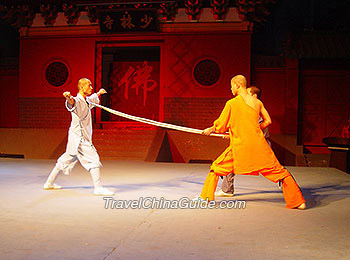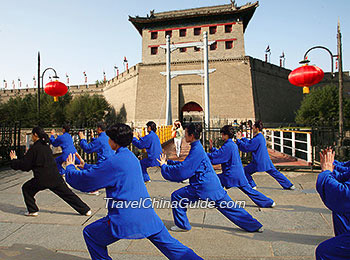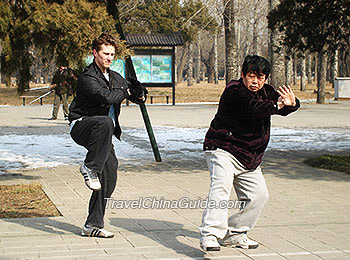Chinese Kung Fu (Martial Arts)
Chinese Kung Fu (Martial Arts or as popularly referred to as Gongfu or Wushu) is a series of fighting styles which has developed over a long historical period in China. Nowadays, it is regarded as a traditional sport gaining more and more popularity and even stands as a representative for Chinese culture. Styles including Shaolin, Tai Chi and Qigong have many followers worldwide. Some westerners think that all Chinese people are Kung Fu masters. That’s not true, but this traditional heritage has its unique existence in modern times and left much influence on the locals’ lifestyle.
Although being fighting styles, Kung Fu advocates virtue and peace, not aggression or violence. This has been the common value upheld by martial artists from generation to generation. With a number of movement sets, boxing styles, weapon skills and some fighting stunts, Kung Fu keeps its original function of self-defense. Now its value in body-building and fitness is also highly appreciated.
In order to survive in an extremely hostile environment, our primitive Chinese ancestors developed primary means of defense and attack that included leaping, tumbling and kicking. Although they knew how to fight with rudimentary weapons made from stones and wood, fighting with bare hands and fists became essential skills. The Martial Arts we recognize today as Kung Fu had their origins in the Shang and Zhou Dynasties (17 century - 256BC). During the following Qin (221 - 207BC) and Han (202BC - 220AD) Dynasties, wrestling, swordplay and spear skills became well developed and were popular among civilians and troops. Following the Song Dynasty (960 - 1279), various schools, boxing styles, movement sets and weapon skills flourished.
Classification
 |
Over the centuries of development in China, Kung Fu has become a large system containing various schools or sects. It is recorded that there are over 300 distinct types of boxing existing around the country. The styles in northern and southern China are quite different. Therefore it is hard to be simply classified
Some of the schools are classified by geographical locations, for example, the Southern Fist (Nanquan) prevailing in south China, and Shaolin School based at Shaolin Temple in Henan Province. Some are named after the creator and master, like the Chen Style Tai Chi and Yang Style Tai Chi. Some are identified by different training methods, such as the Internal Boxing Arts (Neijiaquan) that concentrate on the manipulation of the inner breath and circulation of the body, and the External Boxing Arts (Waijiaquan) concentrating on improving the muscles and the limbs.
The most outstanding and influential schools are listed as follows:
1. Shaolin Martial Arts: Originated in the Shaolin Temple in Henan, this is considered the premier style in China and is widely spread all over the world. Both of its physical exercise and mental training are based upon Buddhist philosophy. The Shaolin Boxing, Southern Fist (Nanquan), Northern Legs (Beitui) and Wing Chun are the representatives of this school.
2. Wudang Martial Arts: This sect has almost the same fame as the Shaolin. Based at the Mt. Wudang in Hubei Province, it is developed under the guidance of Taoist theories. T’ai Chi Ch’uan, Form / Intention Boxing (Xingyiquan), Eight-Diagram Palm (Baguazhang) are essentials of Wudang.
3. Emei Martial Arts: Taking Mt. Emei in Sichuan Province as its camp, this sect is moderate and blends the merits of Shaolin and Wudang. Many sub-branches derive under this sect, including Qingcheng, Tiefo, Qingniu, Dianyi, Huanglin, etc.
 |
| Tai Chi Quan Performance |
5. Form / Intention Boxing (Xingyiquan): It is a representative of Internal Boxing Arts characterized by its straightforward fist and quick attack which are well suitable for fighting against the enemy. Its boxing routines include Five Elements Boxing, Twelve Animals Boxing and so on.
6. Eight-Diagram Palm (Baguazhang): Created by the master Dong Haichuan, the Eight-Diagram Palm features continuous changes in palm styles and steady steps in circle. Many sub-sects derive from this school.
7. Southern Fist (Nanquan): This traditional school prevailed over 400 years in south China. Centered in Guangdong and Fujian Provinces, it features short and tight movements, various skills, steady steps and vigorous attacks. The grand master Wong Fei-hung is good at the Southern Fist.
8. Qigong: It is not only a school of martial arts but also a physical and mental exercise method, which is beneficial to health and body-building. There are mainly two types - Dynamic Qigong practiced by specific body movements, and Static Qigong practiced by adjusting the breath and mind.
 |
| Learn Tai Chi Quan |
In the recent years, learning Chinese martial arts has been more and more popular among people of different ages and nationalities. Therefore, many Kungfu training centers or clubs have been established. A strong will and persistence is the precondition for learning. One should follow a master or join a training school to learn systematically. The basic skills of legs, waist, shoulders and stance training need to be practiced daily. Employing the solid foundation of the basic skills, one can choose from the various sects to learn specific routines of boxing, kicking and weapon skills, to improve the combat ability.
Kung Fu Masters
![]() Bruce Lee: (Nov. 27, 1940 - Jul. 20, 1973) As the founder of Jeet Kune Do, he is a great master who was a brilliant Kungfu movie star in 1970s and made the Chinese Kung Fu well-known throughout the world.
Bruce Lee: (Nov. 27, 1940 - Jul. 20, 1973) As the founder of Jeet Kune Do, he is a great master who was a brilliant Kungfu movie star in 1970s and made the Chinese Kung Fu well-known throughout the world.![]() Yip Man: (Oct.1, 1893 - Dec.2 1972) He was a great martial artist contributing a lot in the development of Wing Chun. He had many students who later became masters in their own right, including Bruce Lee.
Yip Man: (Oct.1, 1893 - Dec.2 1972) He was a great martial artist contributing a lot in the development of Wing Chun. He had many students who later became masters in their own right, including Bruce Lee.![]() Huo Yuanjia: (Jan. 18, 1868 - Aug.9, 1910) As a co-founder of the Chin Woo Martial Arts School, Huo was considered a patriotic and heroic master for defeating many foreign fighters at his time.
Huo Yuanjia: (Jan. 18, 1868 - Aug.9, 1910) As a co-founder of the Chin Woo Martial Arts School, Huo was considered a patriotic and heroic master for defeating many foreign fighters at his time.![]() Wong Fei-hung: (Jul.9, 1847 - 25 Mar.25, 1924) He was a master in Hung Gar Boxing, a style of Southern Fist School.
Wong Fei-hung: (Jul.9, 1847 - 25 Mar.25, 1924) He was a master in Hung Gar Boxing, a style of Southern Fist School.![]() Zhang Sanfeng: (1247 - 1458) He is a legendary martial arts master and ancestor of Wudang School.
Zhang Sanfeng: (1247 - 1458) He is a legendary martial arts master and ancestor of Wudang School.
* There are many other masters, including Chen Wangting - the founder of Chen Style Tai Chi, Yang Luchan - the founder of Yang Style Tai Chi, Dong Haichuan - the creator of Eight-Diagram Palm, Liang Ting - the initiator of International Wing Tsun Association, etc.
Attractions Related to Kung Fu
![]() Shaolin Temple, Henan: The once birthplace of the famous Shaolin School is now a flourishing temple attracting numerous Buddhist disciples and visitors. You can appreciate the historical relics while watching the splendid Kungfu shows.
Shaolin Temple, Henan: The once birthplace of the famous Shaolin School is now a flourishing temple attracting numerous Buddhist disciples and visitors. You can appreciate the historical relics while watching the splendid Kungfu shows.![]() Emei Mountain, Sichuan: Birthplace of Emei School
Emei Mountain, Sichuan: Birthplace of Emei School![]() Mt. Wudang, Hubei: Birthplace of Wudang School
Mt. Wudang, Hubei: Birthplace of Wudang School![]() China Martial Arts Museum in Shanghai
China Martial Arts Museum in Shanghai
Since 1970s, such movies have been more and more popular. People can marvel at the charm of martial arts from the stunning film works like the Fists of Fury, Way of the Dragon, Shaolin Temple, Ip Man, Crouching Tiger and Hidden Dragon, Hero, etc. The famous movie stars include Bruce Lee - the 'King of Martial Arts', Jet Li who has played well many figures in a number of blockbusters, and Jackie Chan noted for his outstanding skills in the film industry at home and abroad.
Martial Arts Novels
This popular genre of Chinese fiction is also well known as Wuxia, which features the adventures of martial artists. Notable writers like Jin Yong, Liang Yusheng and Gu Long have many popular Wuxia works, which have been adapted for movies or TV series and passionately followed by fans.